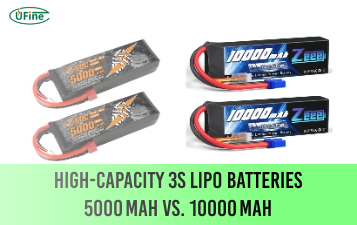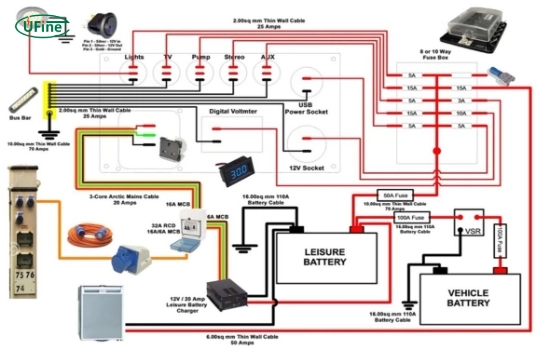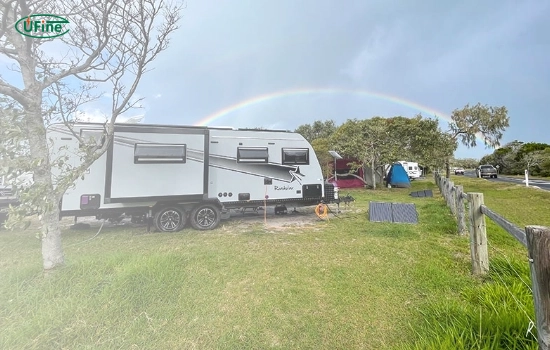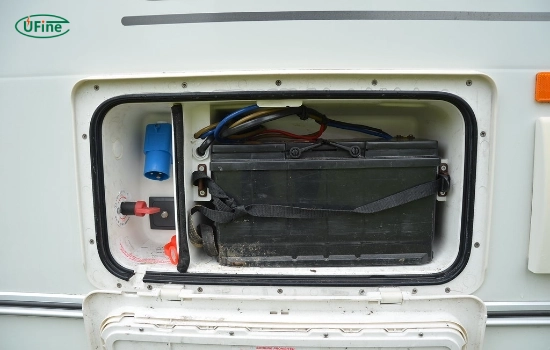If you’re a caravan enthusiast or a newcomer to caravanning, understanding how your caravan battery charges when connected to an electric hook-up is crucial. This knowledge not only ensures that your appliances run smoothly but also prolongs the life of your battery. In this article, we will explore the functionality of caravan batteries, the charging process when connected to an electric hook-up, and how to maintain optimal battery health.
Part 1. Understanding caravan batteries and their functionality
Caravan batteries are essential components that power various systems within your caravan, such as lighting, refrigerators, and water pumps. The two primary types of batteries used in caravans are:
- Starter Batteries: These batteries provide a quick burst of energy to start the vehicle’s engine. They are not suitable for deep cycling.
- Leisure Batteries: Specifically designed for deep-cycle use, leisure batteries can be discharged and recharged multiple times without significant damage. They are crucial for powering appliances when disconnecting the caravan from a power source.
How Do Leisure Batteries Work?
Leisure batteries operate based on a chemical reaction that converts chemical energy into electrical energy. Here’s a detailed breakdown of their functionality:
- Construction: Most leisure batteries are lead-acid batteries. They contain lead and lead dioxide plates submerged in a sulfuric acid electrolyte.
- Discharge and Recharge Cycle: When you use power from the battery, a chemical reaction occurs, causing electrons to flow and power your devices. When you charge the battery, the reaction reverses and restores its chemical state.
- Capacity Ratings: Leisure batteries are rated in amp-hours (Ah), indicating how much power they can supply over time. For instance, a 100Ah battery can provide 5A for 20 hours.
- Depth of Discharge (DoD): Manufacturers design leisure batteries to handle a DoD of around 50%. Discharging them deeper can shorten their lifespan, making it essential to monitor usage.
In summary, understanding leisure batteries involves recognizing their construction, discharge, and recharge processes and how to manage their capacity effectively.
Part 2. What happens when a caravan connects to an electric hook-up?
When you connect your caravan to an electric hook-up, several processes ensure your leisure battery charges efficiently while you use your appliances. Here’s a clear breakdown of what happens:
- Connection Established: The hook-up provides immediate power upon plugging into the electric supply. This allows you to run appliances directly from the mains without using the battery, especially during extended stays.
- Charger Activation: Most caravans come equipped with built-in chargers. Once plugged in, these chargers begin to charge the leisure battery. The efficiency of this charging process can vary based on the type of charger used.
- Power Distribution: While the charger energizes the leisure battery, your caravan’s appliances draw power directly from the hook-up. This dual functionality helps keep your battery topped up while utilizing mains power, reducing the load on the battery.
- Charging Cycle: The charger must maintain an optimal voltage (usually around 14.4V for most leisure batteries) to charge effectively. If the voltage is too low, it may lead to incomplete charging, which can affect the battery’s performance.
- Monitoring and Maintenance: It is advisable to monitor the battery’s voltage and charge state regularly. An intelligent charger can help switch charging modes, optimizing battery health and longevity.
By understanding these processes, you can ensure your leisure battery remains charged and ready for use.
Types of Chargers in Caravans
Caravans typically come equipped with different kinds of battery chargers:
- Basic Chargers: These chargers provide a constant voltage and may not fully charge the battery. They can sometimes lead to overcharging unless monitored.
- Intelligent Chargers: These are more advanced and can adjust the voltage and current based on the battery’s state of charge, ensuring a more complete charge.
Part 3. Charging efficiency and limitations of caravan batteries
Charging efficiency and limitations significantly impact how well your leisure battery functions, especially when connected to an electric hook-up. Here are some key points to consider:
1. Trickle Charging: Many standard chargers employ trickle charging, providing a low, constant charge to the battery. While this method can prevent overcharging, it has significant downsides:
- Slow Charge Rate: Trickle chargers take considerably longer to restore a battery to total capacity, making them inefficient for quick power-ups.
- Inadequate Charging for Deeply Discharged Batteries: If you deeply discharge a leisure battery, a trickle charge may not be enough to restore it to a healthy state, potentially leading to sulfation that can damage the battery.
2. Overcharging Risks: Basic chargers may lack innovative technology to switch off when the battery reaches full charge. Overcharging can lead to heat build-up, electrolyte loss, and damage to the battery plates over time.
3. Voltage Limitations: Ineffective chargers might not provide the necessary voltage levels (ideally around 14.4V) for a complete charge. More voltage can result in extended charging times and incomplete cycles, decreasing battery performance.
4. Regular Monitoring: It’s essential to check your battery’s state during the charging process regularly. Maintaining proper voltage and avoiding prolonged trickle charging will help maximize battery life and efficiency.
Understanding these limitations lets you make informed decisions about maintaining your leisure battery best, ensuring its longevity and reliability.
Part 4. How to charge your caravan battery while driving: advantages and techniques
Charging your caravan battery while driving is a practical solution many users can benefit from. Here’s what you need to know about the advantages and limitations of this method:
1. How It Works: When you connect your caravan to your vehicle, the alternator can power the leisure battery through proper wiring. This process helps maintain the battery’s charge during travel.
2. Advantages of Charging While Driving:
- Convenient: This method allows you to charge your battery without additional power sources, saving time, especially during long trips.
- Maintains Battery Health: Regularly charging your battery while driving helps keep it from discharging completely, preserving its lifespan.
- Efficiency: Typically, the alternator provides a higher voltage output, resulting in a faster charge than hook-up charging methods.
3. Limitations:
- Partial Charging: While this method is beneficial, it usually results in only a partial charge. Engineers only sometimes design the vehicle’s wiring to continuously handle high charging currents, meaning more than charging may be required for deeply discharged batteries.
- Battery Type Considerations: Standard lead-acid batteries can recover well. However, advanced types like lithium require specific conditions that you might not meet while driving.
- Installation Costs: You may need to invest in a dedicated battery-to-battery charger to optimize the charging process while driving.
4. Best Practices:
- Monitor Battery: Just like when charging at home, monitoring your battery’s state during travel ensures you do not overcharge or damage it.
- Upgrade Your Charging System: If you frequently rely on driving to charge your battery, consider upgrading your battery management system for better efficiency during travel.
Charging your caravan battery while driving can be highly beneficial, provided you take the proper precautions and understand its limitations. Ensuring your battery remains charged enhances your caravan experience, allowing for greater independence while on the road.
Part 5. FAQs
-
Does my battery charge while connected to an electric hook-up?
Yes, your leisure battery will charge when connected to an electric hook-up, but the efficiency depends on the type of charger in your caravan -
How long does it take to charge a caravan battery?
Charging times can vary based on the battery’s discharge state and the charger’s output. A fully discharged leisure battery may take several hours to a full day to recharge completely. -
Can I overcharge my caravan battery?
Yes, overcharging can occur, especially with basic chargers. Monitoring the charging process or using an intelligent charger that prevents overcharging is essential. -
What is the ideal voltage for charging a leisure battery?
The ideal charging voltage for a leisure battery is around 14.4V. This voltage ensures that the battery charges effectively without being overcharged. -
How can I maintain my leisure battery?
To maintain its health and longevity, regularly check the battery’s voltage, avoid deep discharges, and ensure it is charged promptly after use.
Related Tags:
More Articles

High‑Capacity 3S LiPo Batteries: 5000 mAh vs. 10000 mAh
Compare 3S LiPo 5000mAh vs 10000mAh batteries by weight, power, and use. Find the best fit for your drone, RC car, or boat setup.
Top 5 Applications for Small 3S LiPo Batteries
Small 3S LiPo batteries power drones, RC gear, wearables, and robotics with high energy and low weight. Making them ideal for compact electronics projects.
Building and Charging Your Own 3S LiPo Pack: A Step‑by‑Step Guide
Learn how to build, balance, and charge a 3S LiPo battery pack safely at home with this complete DIY guide for hobbyists and beginners.
How to Choose the Right LiPo Battery Plug Type?
Discover the best LiPo battery plug types, how to choose them, and expert tips for safe usage, soldering, and maintenance.
Choosing the Right Connector for Your 3S LiPo Battery
Choosing the right 3S LiPo connector depends on current, space, and use. Learn the pros and cons of XT60, JST, EC3, and more.






